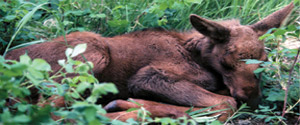
Continued . . .
When the Alaska National Interest Lands Conservation Act was passed on December 2, 1980, the monument designation was dropped, boundary adjustments were made, and the Yukon Flats National Wildlife Refuge was established.
Native Americans within the Yukon Flats at the time of European contact included several bands of Athabascan Indians, largely nomadic hunters dependent on fisheries resources and big game, primarily moose and caribou. An exceptional abundance of furbearers first brought non-native people into the area. The Hudson's Bay Company established Fort Yukon, centrally located within the Refuge, in 1847. After Alaska was purchased by the United States from Russia in 1867, Hudson's Bay Company was forced to relocate back on Canadian soil, and the Alaska Commercial Company assumed operations in Fort Yukon.
Gold was discovered on Birch Creek in 1893 and the community of Circle rapidly expanded to a population of over one thousand people during the gold boom. Though the gold rush era ended, fur trapping continued to expand and by the 1920s Fort Yukon had become the most important fur center in Alaska.
The international importance of the Yukon Flats to migratory waterfowl wasn't fully recognized until after World War II. During the late 1950s a major hydroelectric project was proposed for the Yukon River at Rampart Canyon. The dam, if constructed, would have flooded the entire Yukon Flats and created a lake larger than Lake Erie. Environmental organizations, sportsman's groups, Alaska Native groups, and the U.S. Fish and Wildlife Service took a firm stand against this proposal, and eventually the project died.

